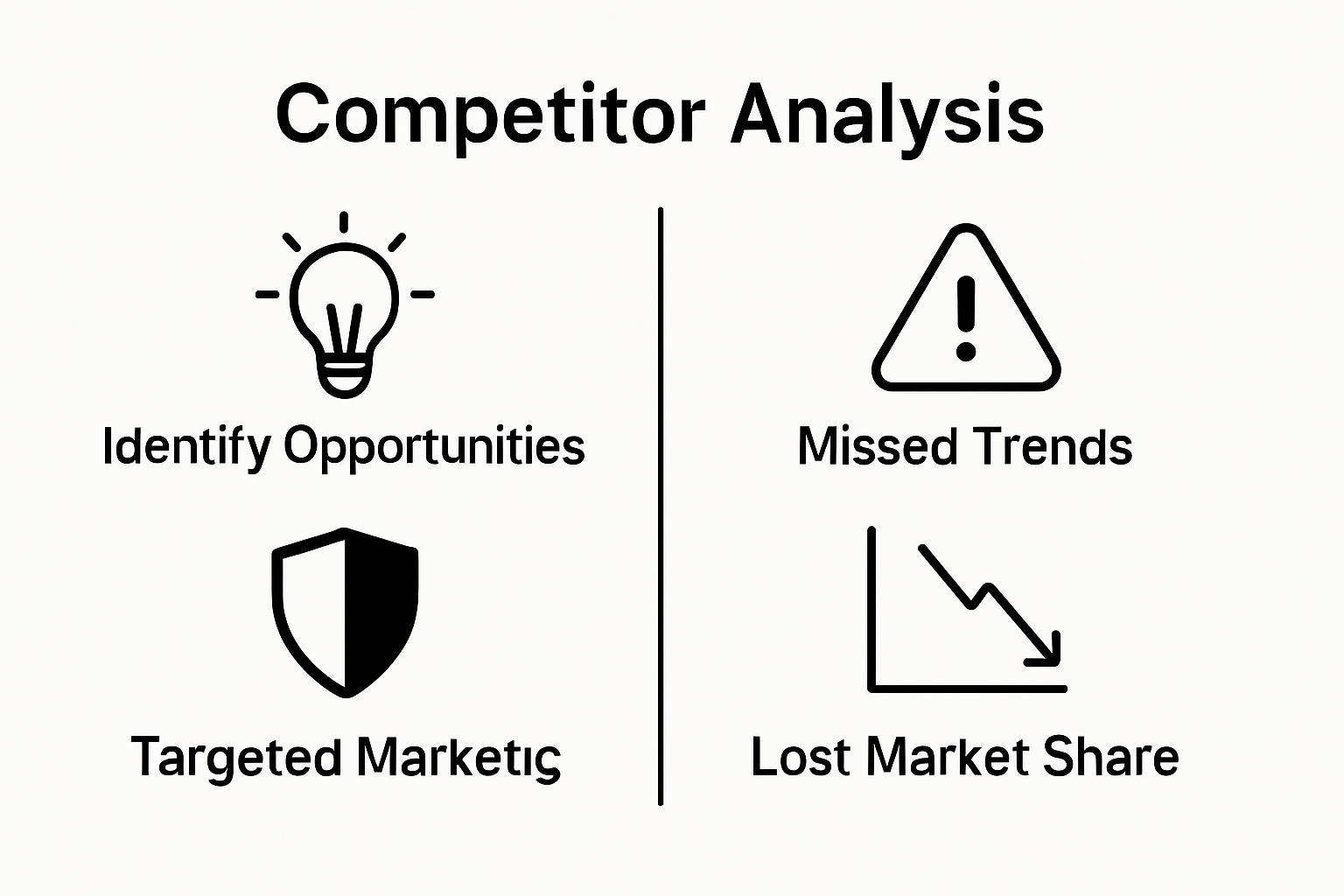Competitor analysis sounds like something reserved for big corporations, but it is actually a secret weapon for any e-commerce business wanting to survive online. Most people guess what their rivals are up to or just copy what looks popular, but that misses the real opportunity. Top e-commerce brands use competitor intelligence not just to react, but to predict trends and shape the future of their industry.
Quick Summary
| Takeaway | Explanation |
|---|---|
| Understand your competition’s strategies | Analyzing competitor strategies helps identify gaps and market opportunities to enhance your own offerings. |
| Leverage actionable insights for differentiation | Use insights from competitor analysis to develop unique products and services that stand out in the market. |
| Monitor industry trends continuously | Keeping track of competitor movements allows businesses to anticipate changes and adjust their strategies proactively. |
| Utilize competitive intelligence for decision-making | Collect and analyze data to make informed decisions regarding pricing, marketing, and customer engagement strategies. |
| Adopt a holistic approach to analysis | Evaluate competitors across multiple dimensions to gain a comprehensive view of the competitive landscape and inform strategic planning. |
What is Competitor Analysis in E-Commerce?
Competitor analysis in e-commerce represents a strategic approach to understanding and evaluating the market landscape by systematically examining the performance, strategies, and tactics of businesses operating in the same digital retail space. This analytical process goes beyond simple observation, providing deep insights into how other online retailers position themselves, attract customers, and create competitive advantages.
Understanding the Core Concept
At its fundamental level, e-commerce competitor analysis involves collecting and interpreting data about other online businesses selling similar products or targeting comparable customer segments. This process helps merchants identify their strengths, weaknesses, opportunities, and potential threats within their specific market niche. By comprehensively studying competitors, e-commerce businesses can develop more informed strategies that differentiate them from others.
The analysis typically encompasses multiple dimensions of business performance, including:
- Product range and pricing strategies
- Website design and user experience
- Marketing and promotional tactics
- Customer engagement approaches
- Digital presence and brand positioning
Strategic Intelligence and Market Positioning
Competitor analysis transforms raw market data into actionable intelligence. It enables e-commerce merchants to understand not just what their competitors are doing, but why they are successful. This deeper understanding allows businesses to make strategic decisions about product development, pricing, marketing campaigns, and customer experience.
For instance, by examining a competitor’s website and customer reviews, an online retailer can identify gaps in product offerings or service quality that present opportunities for differentiation. Learn more about creating a competitive content strategy that helps you stand out in a crowded digital marketplace.
Ultimately, competitor analysis is not about copying others, but about understanding the market dynamics and positioning your e-commerce business to provide unique value that attracts and retains customers more effectively than your competitors.
The Importance of Understanding Your Competition
In the dynamic world of e-commerce, understanding your competition is not just a strategic advantage but a critical survival mechanism. Businesses that fail to comprehend their competitive landscape risk becoming obsolete, losing market share, and missing crucial opportunities for growth and innovation.
Why Competitive Awareness Matters
Competitive awareness transforms how e-commerce businesses approach their market strategy. It provides invaluable insights into industry trends, customer preferences, and potential gaps in the current market offerings. By closely monitoring competitors, merchants can anticipate market shifts, understand emerging consumer needs, and develop proactive strategies that position them ahead of the curve.
The strategic benefits of competitive understanding include:
This table highlights strategic benefits gained from cultivating a strong understanding of your e-commerce competition.
| Strategic Benefit | Impact on E-Commerce Business |
|---|---|
| Identify unexplored opportunities | Spot new markets or products for growth |
| Recognize potential threats | Take proactive measures to defend or pivot business strategies |
| Understand evolving expectations | Adapt to changing customer needs and improve offerings |
| Benchmark performance | Measure success and set achievable goals |
| Targeted and effective marketing | Create campaigns that resonate and outshine competitors |

- Identifying unexplored market opportunities
- Recognizing potential threats before they become critical
- Understanding evolving customer expectations
- Benchmarking performance against industry standards
- Developing more targeted and effective marketing approaches
Strategic Decision Making Through Competitive Intelligence
Competitive intelligence goes beyond simple observation. It is a sophisticated process of gathering, analyzing, and interpreting information about market dynamics and competitor behaviors.
This intelligence enables e-commerce businesses to make data-driven decisions that can significantly impact their growth and profitability.
For example, by understanding a competitor’s pricing strategy, product lineup, or customer engagement techniques, businesses can develop more nuanced and effective approaches. Check out our guide on creating a robust content marketing strategy that helps you leverage competitive insights effectively.
Ultimately, competitive understanding is about building a comprehensive view of your market ecosystem. It allows businesses to not just react to changes, but to anticipate and shape market trends, creating a sustainable competitive advantage that goes beyond immediate tactical responses.
How Competitor Insights Drive Business Strategy
Competitor insights serve as a powerful catalyst for transforming business strategy in e-commerce, providing merchants with a comprehensive understanding of the market dynamics that shape strategic decision-making. By translating competitive data into actionable intelligence, businesses can develop nuanced approaches that go beyond reactive measures and into proactive market positioning.
Translating Data into Strategic Advantage
Competitive insights function as a strategic compass, guiding e-commerce businesses through complex market landscapes. These insights help merchants understand not just the current market state, but potential future trajectories. By systematically analyzing competitors’ behaviors, performance metrics, and strategic moves, businesses can identify patterns and trends that inform their own strategic planning.
Key strategic dimensions influenced by competitor insights include:
- Product development and innovation
- Pricing and positioning strategies
- Marketing and customer acquisition approaches
- Customer experience enhancement
- Operational efficiency improvements
Predictive Strategy and Market Adaptation
Competitor insights enable businesses to anticipate market shifts before they occur, transforming strategic planning from a reactive to a predictive model. This forward-looking approach allows e-commerce merchants to develop flexible strategies that can quickly adapt to changing market conditions.
Explore our comprehensive guide on growing e-commerce sales to understand how competitive insights can be leveraged for sustainable business growth. By understanding competitors’ strengths and weaknesses, businesses can create unique value propositions that distinguish them in crowded marketplaces.
The ultimate goal of leveraging competitor insights is not imitation, but innovation. Businesses that successfully interpret and act on competitive intelligence can create distinctive strategies that not only respond to market conditions but also actively shape them, establishing themselves as leaders rather than followers in their respective e-commerce niches.
Key Concepts in Effective Competitor Analysis
Effective competitor analysis requires a structured and systematic approach that goes beyond surface-level observations. It demands a comprehensive understanding of multiple strategic dimensions that collectively provide a holistic view of the competitive landscape in e-commerce.
Foundational Elements of Competitive Intelligence
Competitor analysis is not a singular activity but a multifaceted process that integrates various analytical techniques. Successful e-commerce businesses recognize that competitive intelligence is an ongoing, dynamic framework that continuously evolves with market changes. This approach involves collecting, processing, and interpreting data from multiple sources to generate actionable insights.
The core components of effective competitor analysis include:
The following table summarizes the main dimensions and criteria involved in effective competitor analysis for e-commerce businesses.
| Dimension | Description |
|---|---|
| Data Collection | Gathering information from digital platforms about competitors’ activities and presence |
| Performance Benchmarking | Comparing key metrics to industry or top competitor standards |
| Market Positioning Evaluation | Assessing how competitors present themselves and target their audience |
| Continuous Monitoring | Regularly tracking competitor strategies and industry changes |
| Strengths and Weaknesses Assessment | Objectively analyzing competitors’ pros and cons relative to your own business |
- Comprehensive data collection across digital platforms
- Rigorous performance benchmarking
- Systematic evaluation of market positioning
- Continuous monitoring of competitive strategies
- Objective assessment of strengths and weaknesses
Strategic Dimensions of Competitive Evaluation
Competitive analysis extends far beyond simple comparison. It requires a nuanced understanding of how different strategic elements interconnect and influence market performance. E-commerce merchants must develop a sophisticated approach that examines competitors through multiple lenses, including technological infrastructure, customer experience, marketing strategies, and product innovation.
Discover our guide on growing e-commerce sales to understand how strategic competitive insights can transform your business approach. By developing a multidimensional view of the competitive landscape, businesses can identify unique opportunities for differentiation and growth.
Ultimately, effective competitor analysis is about developing a deep, contextual understanding of the market ecosystem. It empowers businesses to move beyond reactive strategies, enabling them to anticipate market shifts, identify emerging trends, and proactively shape their competitive positioning in the dynamic world of e-commerce.

Practical Applications of Competitor Analysis for Growth
Competitor analysis transcends theoretical understanding, offering tangible strategies that e-commerce businesses can implement to drive meaningful growth. By transforming competitive insights into actionable strategies, merchants can create targeted approaches that differentiate their brand and capture market opportunities.
Strategic Product and Pricing Optimization
Competitive analysis provides a direct pathway to product and pricing refinement. By systematically examining competitors’ product offerings, pricing models, and market positioning, e-commerce businesses can identify gaps and opportunities that enable more strategic decision-making. This approach allows merchants to develop product lines that address unmet customer needs or create pricing strategies that provide superior value.
Key strategic applications of competitive insights include:
- Identifying underserved market segments
- Developing unique product features
- Creating competitive pricing structures
- Understanding customer preference trends
- Anticipating market evolution
Marketing and Customer Acquisition Strategies
Competitive intelligence transforms marketing approaches from generic campaigns to precision-targeted strategies. By understanding competitors’ marketing channels, messaging, and customer engagement techniques, businesses can develop more nuanced and effective marketing initiatives that resonate with their target audience.
Explore our free e-commerce keyword generator to enhance your competitive marketing research and identify strategic keyword opportunities that can differentiate your brand.
Ultimately, practical competitor analysis is about turning market intelligence into a strategic advantage. Successful e-commerce businesses view competitive insights not as static information, but as a dynamic tool for continuous improvement, innovation, and strategic positioning in an increasingly complex digital marketplace.
Turn Competitor Insights Into Results With MarketingSuite.app
After reading about the power of competitor analysis, you probably feel the weight of staying ahead in the fast-changing e-commerce world. Understanding what your competitors do is only half the battle. Acting on that knowledge quickly and consistently is what separates top brands from the rest. Many merchants struggle to monitor rivals, create consistent messaging, and adapt in real time to shifting market trends. If you want to boost engagement and stay close to your audience, start exploring our Customer Engagement resources to deepen customer relationships and outmaneuver your competition.

Why wait for market changes to leave you behind? MarketingSuite.app is built to turn competitor monitoring and actionable insights into a single, automated workflow. You can turn analysis into on-brand content, targeted campaigns, and smarter product updates. Visit https://marketingsuite.app now to see how easy it is to publish faster, target smarter, and drive growth while your competitors are still scrambling. Stay competitive, act today to turn market intelligence into profit.
Take Control of Your Market Position Today
The difference between e-commerce merchants who thrive and those who struggle often comes down to one critical factor: how quickly they can turn competitor intelligence into decisive action. While your competitors are still manually checking prices and guessing at market trends, you have the opportunity to build a systematic approach that transforms competitive data into measurable growth.
The path forward isn’t about implementing complex systems overnight. Start with these three high-impact actions you can execute within the next 48 hours:
Implement Weekly Competitor Price Audits: Choose your top 5 competitors and manually track their pricing for your bestselling products every Monday. Research shows that businesses monitoring competitor prices see 7-15% improvement in profit margins within the first quarter. Set up simple spreadsheets with price alerts to identify when competitors drop prices by more than 10%.
Monitor One Competitor’s Marketing Strategy: Pick your strongest direct competitor and subscribe to their email list, follow their social media, and bookmark their key product pages. Document their promotional patterns, messaging changes, and product launches. 77% of businesses using systematic competitor analysis tools report staying ahead of market shifts.
Track Customer Sentiment Weekly: Dedicate 30 minutes each Friday to reading recent reviews of your top 3 competitors’ bestselling products. Look for recurring complaints or praise patterns that reveal gaps in the market. This intelligence directly informs your product positioning and customer experience improvements.
These foundational steps create the competitive awareness that separates market leaders from followers. The businesses that act on competitive intelligence today are the ones that will capture market share tomorrow, while those that delay will find themselves reacting to changes they should have anticipated.
Frequently Asked Questions
» What is competitor analysis in e-commerce?
Competitor analysis in e-commerce is the strategic process of evaluating the performance, strategies, and tactics of businesses in the same digital marketplace. It helps online retailers understand their position and identify opportunities for growth and differentiation.
» Why is understanding the competition important for e-commerce businesses?
Understanding the competition is crucial for e-commerce businesses as it allows them to identify market trends, customer preferences, and gaps in offerings. It enables merchants to anticipate market shifts and develop effective strategies for growth and sustainability.
» How can competitor insights influence business strategy?
Competitor insights guide e-commerce businesses in product development, pricing, marketing, and customer experience strategies. By analyzing competitors, businesses can adapt their approaches to meet market demands and distinctively position themselves against others.
» What are the key components of effective competitor analysis?
Effective competitor analysis involves comprehensive data collection, performance benchmarking, evaluation of market positioning, continuous monitoring of competition, and objective assessment of strengths and weaknesses. These elements help businesses gain a holistic view of the competitive landscape.
Recommended
-
- How to Create Content Marketing Strategy for E-Commerce Merchants: A Step-by-Step Guide – Marketing Suite
- Understanding Customer Engagement: A Comprehensive Guide – Marketing Suite
- Content Marketing for E-commerce: The Ultimate Strategy Guide for Online Merchants – Marketing Suite
- How to Grow Ecommerce Sales by 50% in 2025


Leave a Reply